Frogs are fascinating creatures, known very well for their unique (yet, iconic) hopping movements and distinct croaking sounds. What can set frogs apart from other animals in the animal kingdom is their ecological role. In many different kinds of environments, frogs act as important indicators of environmental health. And they thrive anywhere from the lush rainforests of South America to the wetlands of North America. Enclosed in the article below are some of the most amazing species of frogs from around the world!
1. Red-Eyed Tree Frog (Agalychnis callidryas)
Found in Central America and Mexico, the red-eyed tree frog is one of nature’s most remarkable amphibians. Their radiant green bodies, vividly embellished with yellow, blue, and of course, their iconic red eyes, are mesmerizing. They’re not poisonous and are excellent climbers who spend most of their time idling on the leaves. These incredible frogs are truly fascinating, but let’s not forget that they are just one among many wonders!
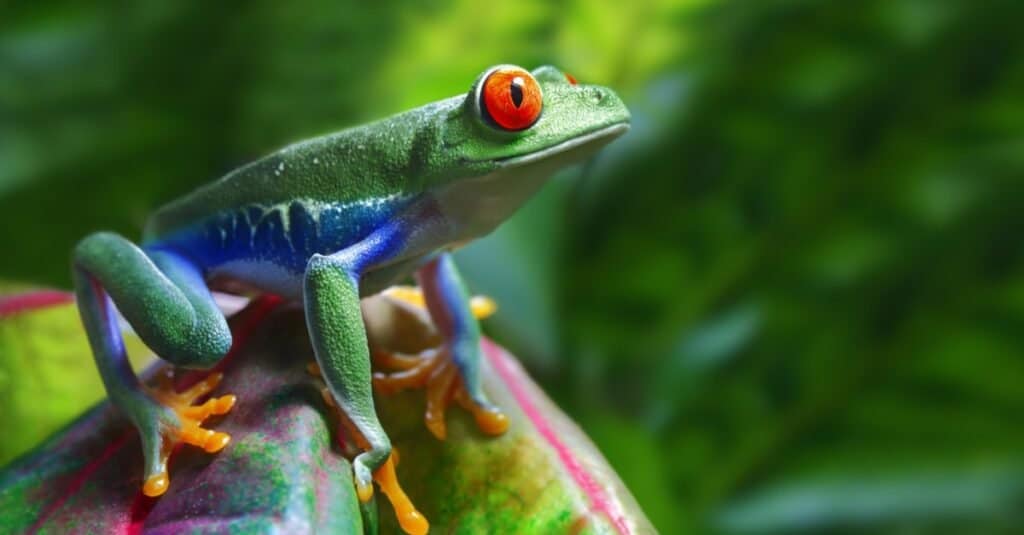
A colorful red-eyed
tree frog
in its tropical setting. Tree frogs sing to announce their territories and to attract females.
©Brandon Alms/Shutterstock.com
2. Glass Frog (Centrolenidae)
Glass frogs, native to Central and South America, earn their moniker due to their translucent skin. They are arboreal frogs and live mostly in the trees of the rainforest. Glass frogs have incredible, high-pitched calls that some say sound like screaming. Most incredible though is this little fella’s skin, which, as you can see, is very revealing of their body’s internal organs. While small and delicate, these fascinating creatures are non-poisonous— just pretty to look at.
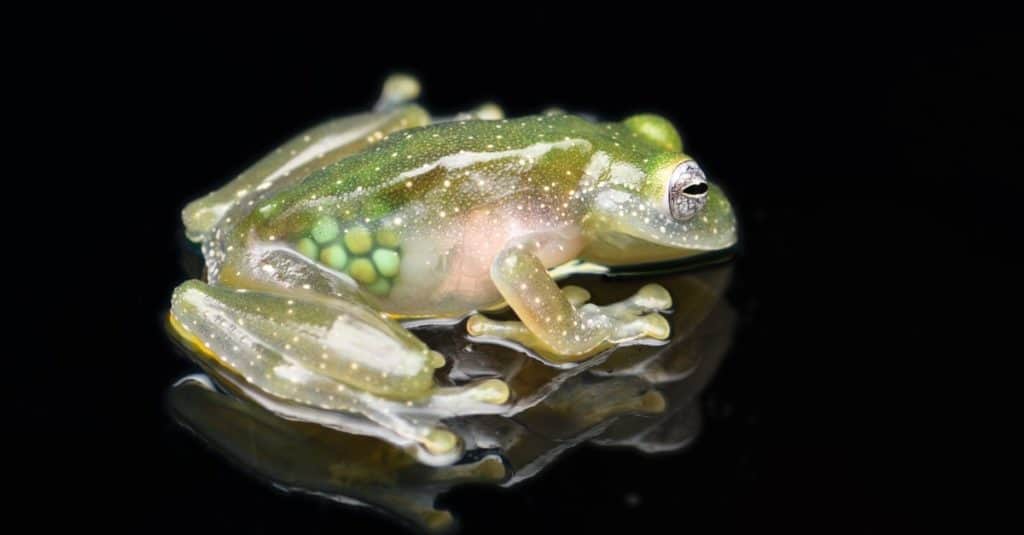
Glass frogs have incredible, translucent skin, revealing their body’s internal organs.
©petrdd/Shutterstock.com
3. Amazon Milk Frog (Trachycephalus resinifictrix)
The Amazon milk frog is an arboreal giant native to the Amazon Rainforest in South America. It’s quite recognizable by its blue complexion, and also by the sticky, milk-like substance it secretes when threatened. The Amazon milk frog is a unique species that has adapted to its environment, living off of small insects and spiders. It prefers to dwell in the upper canopy of trees, making it difficult for humans to observe it in its natural habitat.

Majestic and elusive, the Amazon Milk Frog goes by many different names: the Amazonian cave frog, milky frog, blue milk frog, and golden-eyed milk frog.
©Kurit afshen/Shutterstock.com
4. Giant African Bullfrog (Pyxicephalus adspersus)
A southern African native, the African bullfrog is a hefty amphibian, ranking as Africa’s largest — growing up to a foot in length and weighing up to four pounds. Typically donning an olive green complexion with light underbelly markings, these bullfrogs wield powerful jaws equipped with razor-sharp teeth. They prove themselves as ravenous predators by feeding on anything from insects and rodents to snakes and small birds.
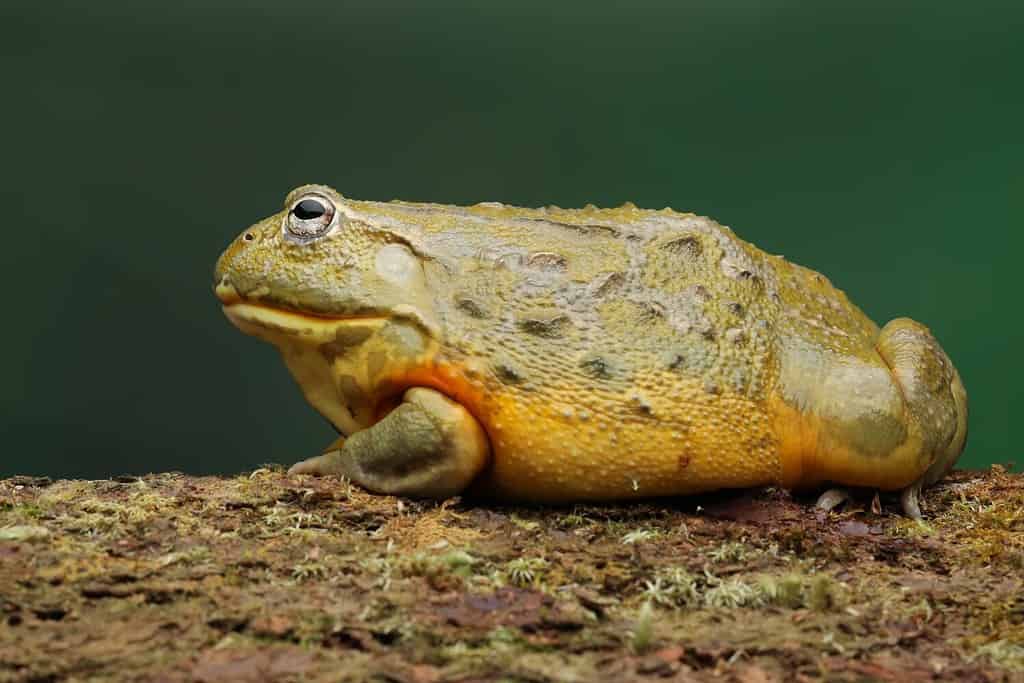
The giant African
bullfrog
is a ravenous predator and eats just about anything it can fit in its mouth.
©Lauren Suryanata/Shutterstock.com
5. Pobblebonk Frog (Limnodynastes dumerilii)
The pobblebonk frog, also known as the eastern banjo frog, is one of the world’s loudest amphibians. During the breeding season, males produce a loud, resonating “bonk” call to attract females. This “bonk” sound/call can reach up to 120 decibels! Pobblebonk frogs are nocturnal and spend most of their time burrowed underground. These creatures emerge under the cover of darkness to hunt and nourish themselves.

The pobblebonk frog lives in eastern Australia.
©iStock.com/photodeer
6. Lake Titicaca Water Frog (Telmatobius culeus)
The Lake Titicaca frog boasts unique features that make it a perfect fit for its natural habitat. These frogs are among the world’s largest aquatic frogs, measuring up to 20 inches in length and weighing up to 2 pounds! They have a leisurely metabolism, but when their hunger does strike, they relish in a hearty diet of amphipods, insects, snails, fish, and worms. These amphibians inhabit solely the shores of Lake Titicaca — tucked away in the enchanting Andean Highlands of South America.
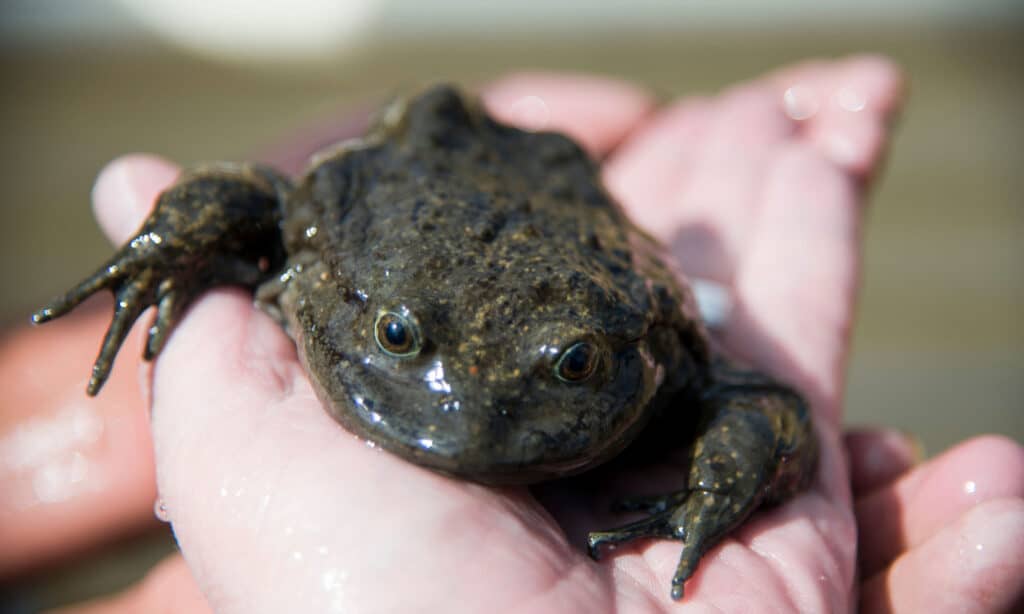
A single female Lake Titicaca water frog is capable of laying up to 500 eggs at once!
©Andreas Wolochow/Shutterstock.com
7. Harlequin Frog (Atelopus)
The harlequin frog is native to the rainforests of Central and South America. These frogs are unique and fascinating creatures. They are famous for their vibrant displays of color and striking patterns, which not only serve to attract potential mates but also act as a warning to predators of their poisonous nature. In addition, the harlequin frog has another unique defense mechanism. When threatened it will assume a defensive position with its arms spread out. This helps to scare away predators and can even cause them to change direction.
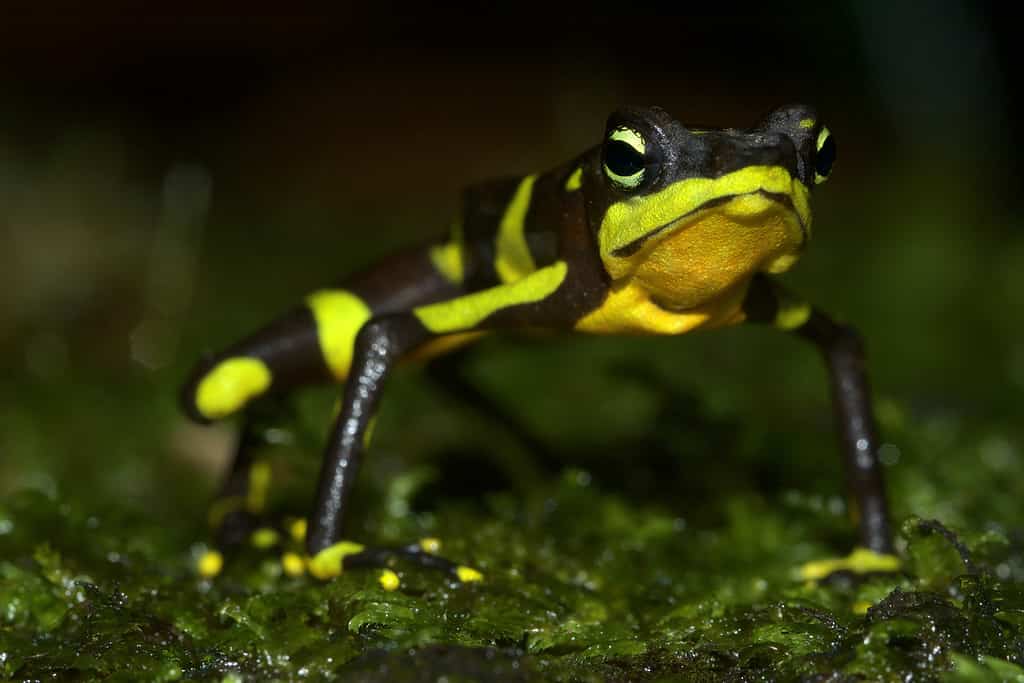
The Limosa harlequin frog is an endangered species and only lives in Panama.
©iStock.com/Maria Ogrzewalska
8. Giant Monkey Frog (Phyllomedusa bicolor)
The giant monkey frog is an impressive species, boasting the title of being the largest tree frog in the world. Reaching up to 6 inches (15 cm) in length, these frogs are arboreal, meaning that they live in trees and tend to be active during nocturnal hours. They produce a distinctive call, which is a series of loud, guttural “wok” sounds. Although their skin secretions can be irritating to humans, they are an important part of rainforest ecosystems as they help control populations of insects and other small animals.
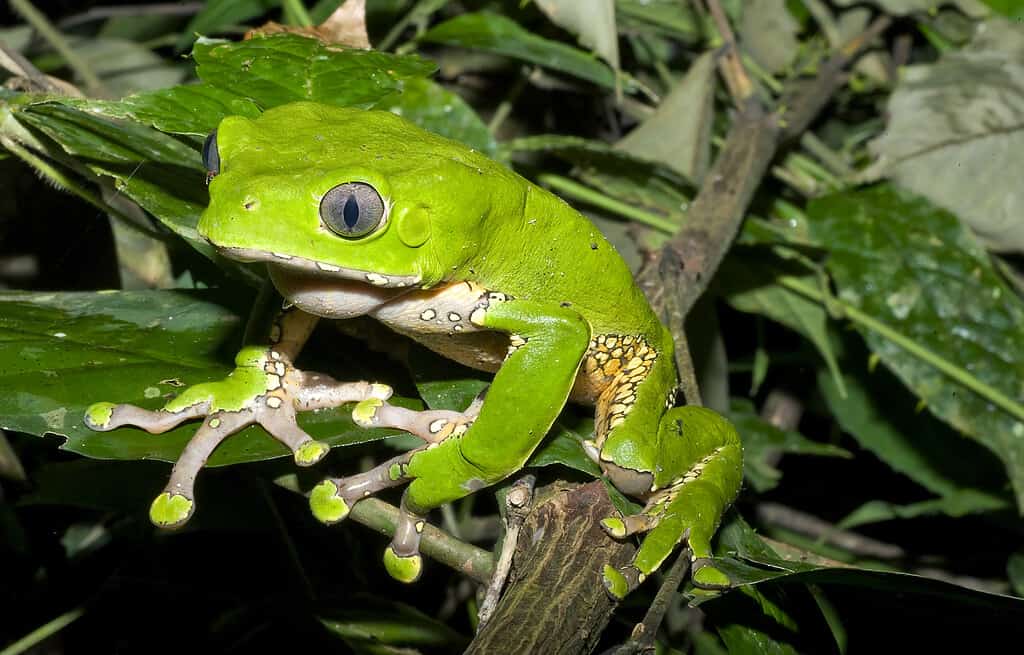
The giant monkey frog is also called the giant leaf frog, waxy-monkey tree frog, or bicolor tree frog.
©iStock.com/webguzs
9. Tomato Frog (Dyscophus guineti)
You might have guessed it, but the tomato frog’s name comes from the fact that it looks like a big red tomato! Male frogs are a yellow-orange color, while females are usually a brighter red-orange color. They defend themselves by releasing a toxic secretion through their skin, and by inflating themselves to look bigger. Tomato frogs are found in Madagascar and live in rainforests and swamp forests.
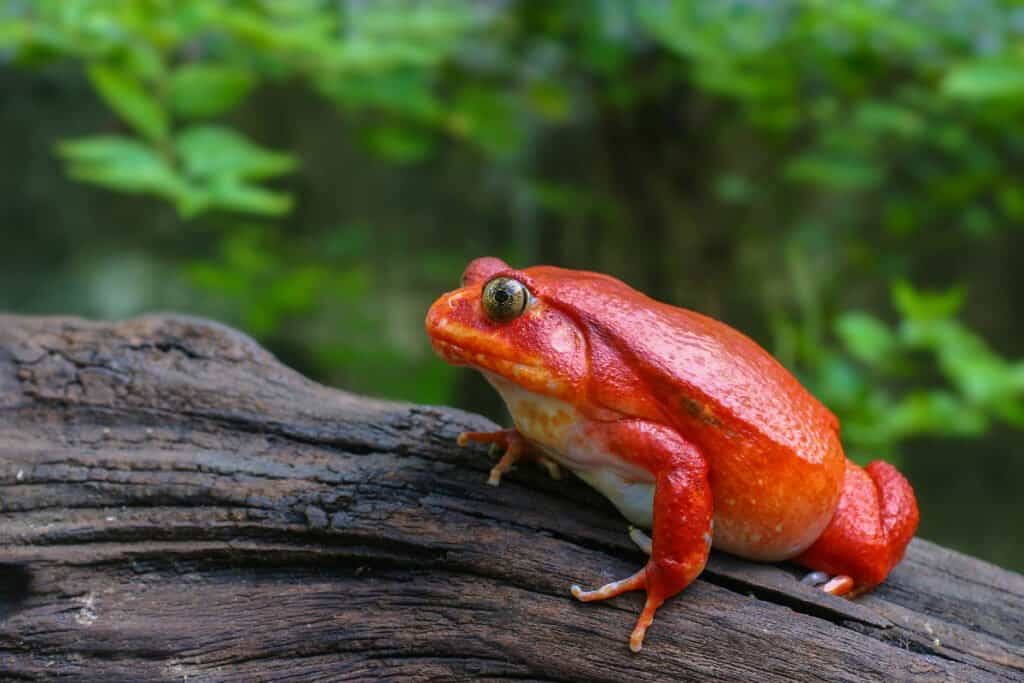
Tomato frogs’ funny little faces have made them increasingly popular pets
©Krisda Ponchaipulltawee/Shutterstock.com
10. Riggenbach Reed Frog (Hyperolius riggenbachi)
Found in parts of Africa, the Riggenbach red frog is a small to medium-sized amphibian measuring 1 to 1.5 inches. It belongs to the Hyperoliidae family, a group of tropical and subtropical tree frogs native to Africa. The Riggenbach reed frog is an ectothermic amphibian that uses heat from its surroundings to regulate its body temperature. This adaptation makes it well-suited to thrive in hot and arid climates. Fascinatingly, the Riggenbach reed frog can also enter into a state of suspended animation, called aestivation, during the dry season to conserve water.
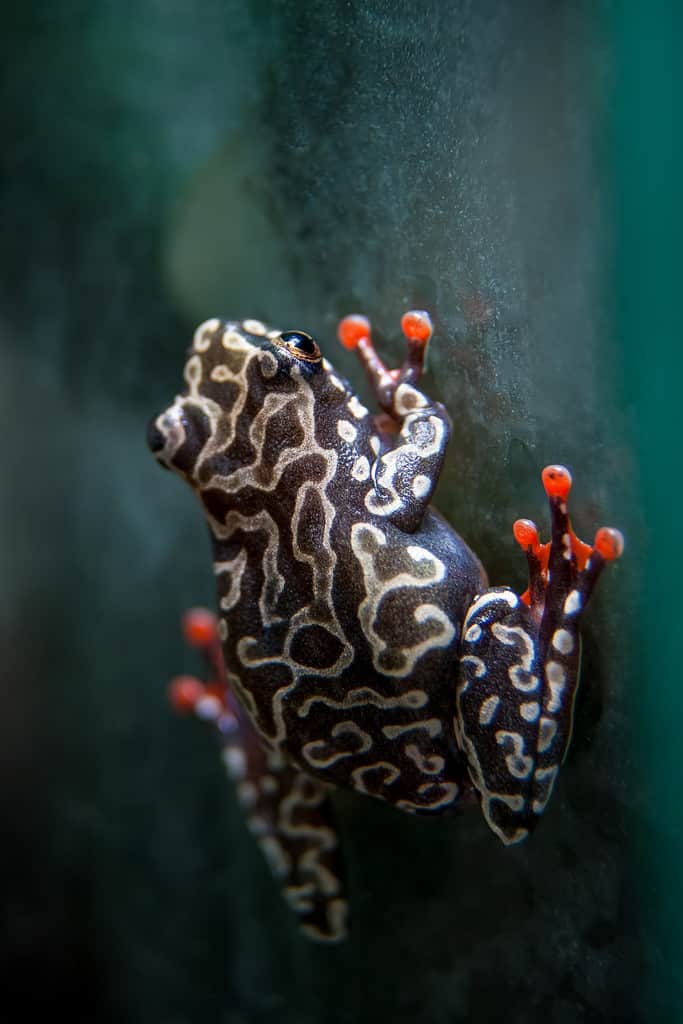
The Riggenbach reed frog has red fingers and toes.
©iStock.com/Farinosa
11. Wallace’s Flying Frog (Rhacophorus nigropalmatus)
Living in the Malay Peninsula in western Indonesia, Wallace’s flying frog is one of the most incredible frogs in the world! It is one of the biggest frogs in its family, measuring 3 to 4 inches long. Its gigantic eyes have horizontal pupils, and it also has pretty big eardrums. The frog’s long limbs end in unique webbing between its fingers and toes that allow it to jump and glide down to the forest floor from high up in the trees like a parachute.
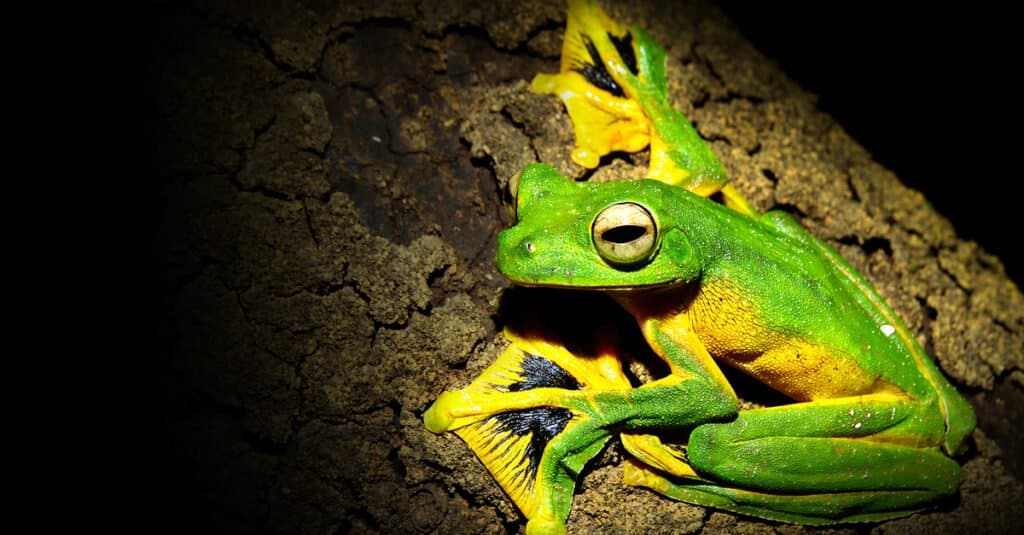
With their unique webbed feet, Wallace’s flying frogs jump between branches.
©Binturong-tonoscarpe/Shutterstock.com
12. Asian Painted Frog (Kaloula pulchra)
These frogs are 2 to 3 inches long with striking dark brown bodies and copper brown or pink stripes. They live in Southeast Asia in both rural settings, urban areas, and forest habitats. When it gets dry, the frogs dig down and bury themselves underground. After it rains, they re-emerge and call for their mates. When Asian-painted frogs feel threatened, they inflate their lungs and secrete a noxious white substance to ward off attackers.

Asian-painted bullfrogs are also sometimes called
chubby frogs
.
©Silarock/Shutterstock.com
Poison Dart Frogs (13 through 22)
These guys are relatively well known as a category to the public. They make up the last of our most incredible frogs around the world, and so I decided to put them in their section at the end since they all belong to the category of poison dart frogs. What makes them unique and incredible, and some of the most intriguing frogs from around the world, are their beautiful colors, tiny little size, and extremely poisonous effects. It’s no surprise that these charming creatures are among the 22 most intriguing frogs in the world!
13. Golden Poison Frog (Phyllobates terribilis)
In Colombia lives a frog that just might be the most poisonous creature on earth — the golden poison frog (Phyllobates terribilis). Its batrachotoxin-packed poison could take out ten men! The neurotoxin works by obstructing nerve cell sodium channels, resulting in paralysis and a not-so-pleasant demise. On the bright side, these frogs are quite beautiful, with brilliant yellow and black stripes. They can be found in the Chocó Rainforest near Colombia’s Pacific Coast.

For centuries, the Emberá people of Colombia have utilized the potent venom of the golden poison dart frog to tip their blowgun darts when out on hunting expeditions.
©reptiles4all/Shutterstock.com
14. Dyeing Poison Dart Frog (Dendrobates tinctorius)
This frog is found in Guyana, Suriname, French Guiana, and Venezuela. It is not as poisonous as the golden poison frog, but it is still very toxic. The poison is a compound called tetrodotoxin, which is also found in pufferfish and blue-ringed octopuses. It is a very powerful neurotoxin and even small amounts can cause paralysis or death. The main predators of this frog are snakes, which have developed a resistance to the toxin in its skin.

Dyeing poison dart frogs live in wet and humid forests, typically around rocky, cool streams of running water.
©iStock.com/Frank Cornelissen
15. Strawberry Poison Dart Frog (Oophaga pumilio)
This frog is found in Costa Rica and Panama. It has a bright yellow body and orange legs. The head is covered in black spots with the occasional white spot on its face and throat. It can grow up to 2.5 inches in length and inhabits lowland areas near streams, ponds, and marshes. This species of frog is said to be aggressive, often attacking other frogs and small animals that venture too close.

Strawberry poison dart frogs mainly live on the forest floor, often in leaf litter.
©Nature’s Charm/Shutterstock.com
16. Red-Backed Poison Dart Frog (Ranitomeya Reticulata)
The red-backed poison frog is found in the lush Amazon rainforest, flourishing in both Peru and Ecuador. This tiny yet vibrant creature is one of the smallest poison dart frogs known, with fully grown adults measuring only 12-15 millimeters (about 0.5 inches) in length! The red-backed poison dart frog is an arboreal species and is found in lowland rainforests. These frogs spend most of their time in trees, often residing in the lower levels of the forest. They lay their eggs in leaf litter or vegetation and leave their tadpoles in small pools of water to develop.
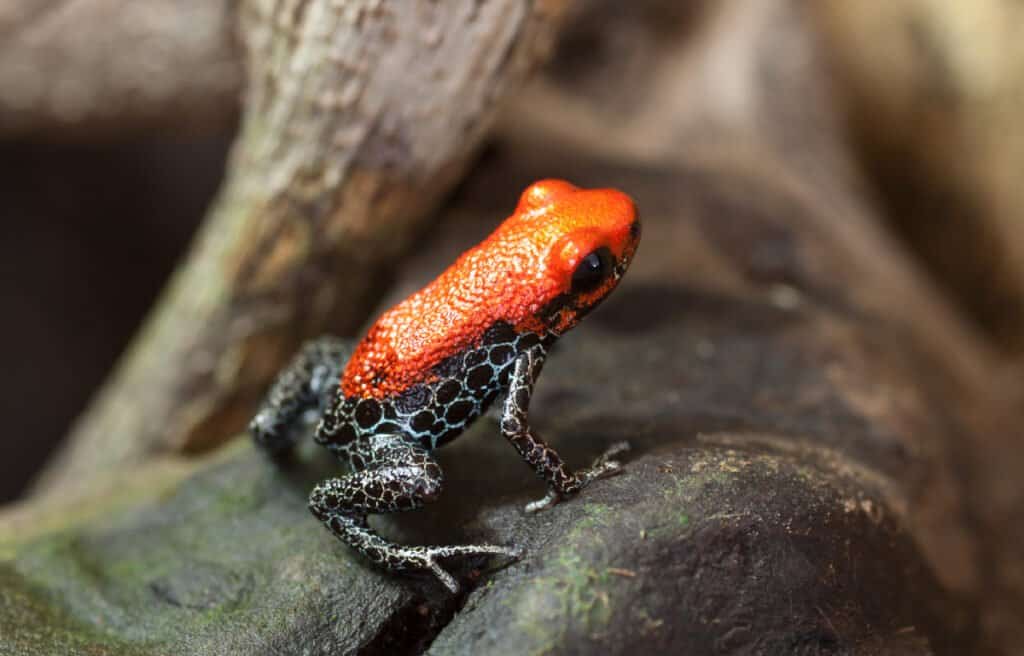
Breeding season for red-backed poison dart frogs begins at the end of the wet season.
©Klaus Ulrich Mueller/Shutterstock.com
17. Yellow Banded Poison Dart Frog (Dendrobates leucomelas)
The yellow-banded poison dart frog is a remarkable creature that lives in the northern rainforests of South America. These tiny frogs rarely get bigger than 1.5 inches and have black bodies with bright yellow markings. Due to its appearance, sometimes it is also called the bumblebee poison frog. Like other poison dart frogs, these frogs also secrete deadly toxins. Despite its inherent dangers, the yellow-banded poison dart frog is a sought-after pet, which causes problems for its populations in the wild.
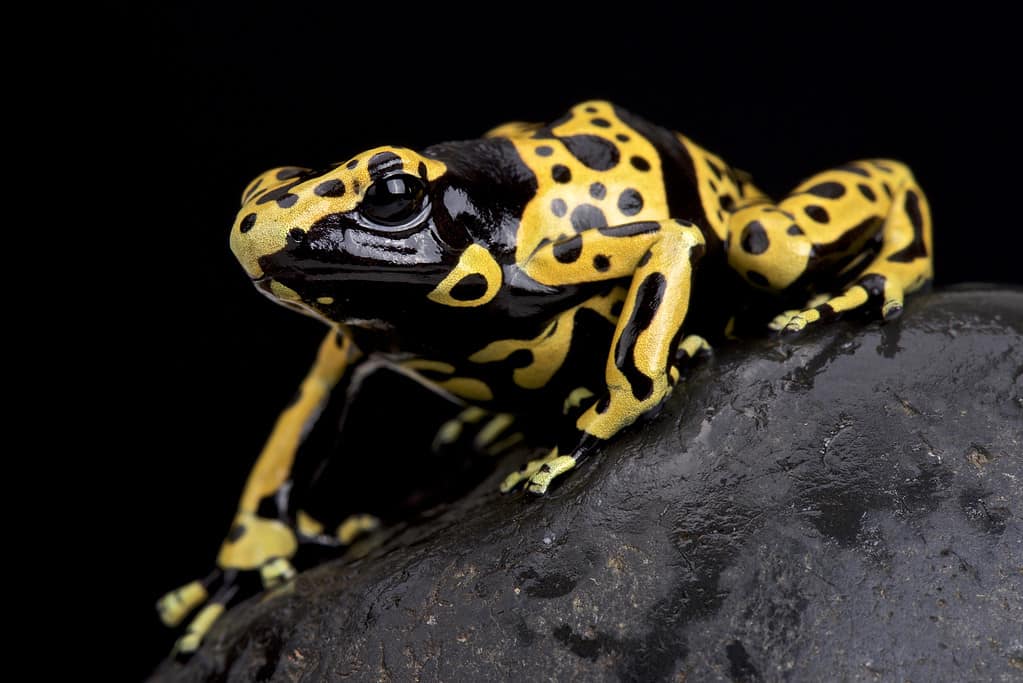
The yellow-banded poison dart frog lives in rainforest regions of Brazil, Guyana, Venezuela, and some eastern extremes of Colombia.
©iStock.com/reptiles4all
18. Mimic Poison Frog (Ranitomeya imitator)
The bright-yellow mimic poison frog measures between 0.4 to 0.8 inches from snout to vent. Though small in size, this diurnal and terrestrial amphibian inhabits the damp montane forests at 4,900 to 8,200 feet above sea level. It feeds primarily on insects and small invertebrates. This incredible frog has many color morphs and mimics other poison frogs in its environment.
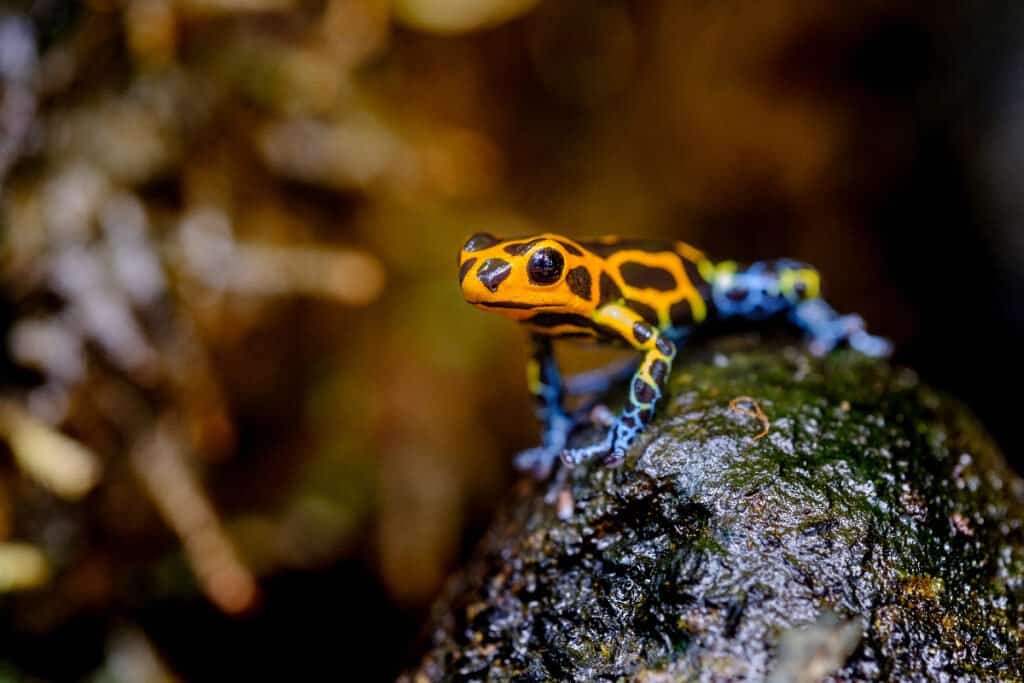
The mimic poison frog lives in eastern Peru.
©Frank Cornelissen/Shutterstock.com
19. Reticulated Poison Frog (Ranitomeya ventrimaculatus)
The lush rainforests of South America are home to so many fascinating species, including the vibrant reticulated poison frog. This small, brightly colored amphibian is armed with toxic skin that repels predators as well as bacteria and fungi. Reticulated poison frogs only grow up to 0.8 inches at the most, and male frogs are small than female frogs.
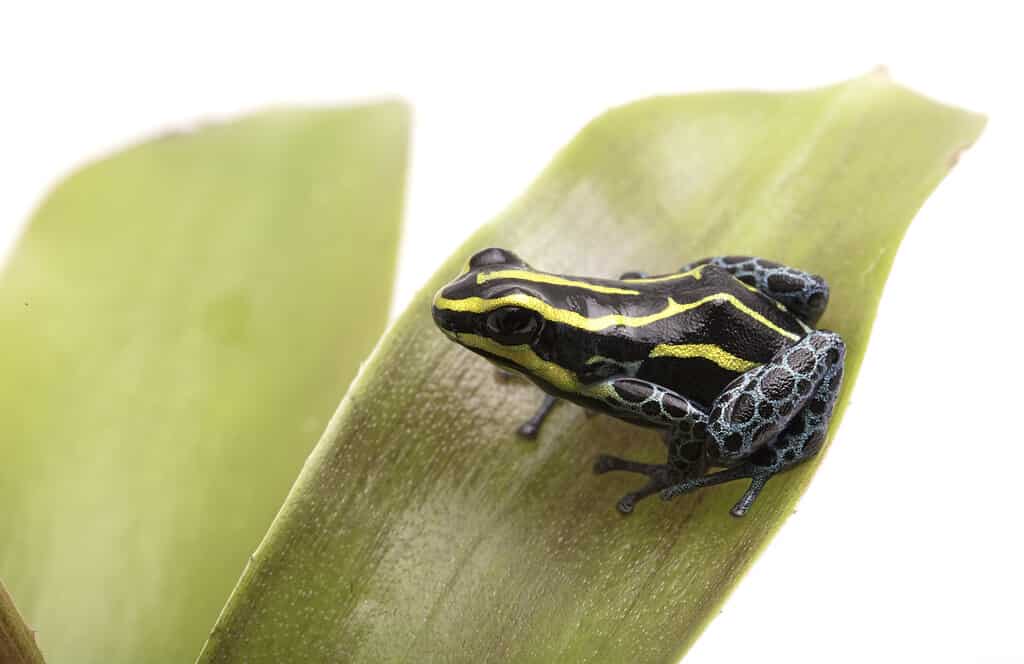
It takes 60 to 80 days for reticulated poison tadpoles to develop into frogs.
©iStock.com/kikkerdirk
20. Three-Striped Poison Frog (Ameerega trivittata)
The three-striped poison frog is a captivating species, renowned for its stunning appearance. These charming creatures are adorned with smooth, jet-black skin and measure about 1.5 inches long. Their limbs sport a delicate mesh of cool, calming blues, greys, and greens that only add to their alluring charm. What’s most remarkable, however, is the bright lateral striping of oranges, and reds that run along their torsos, providing a vibrant contrast. In terms of morphology, there is no explicit sexual differentiation in this species, although females tend to be slightly larger than their male counterparts.
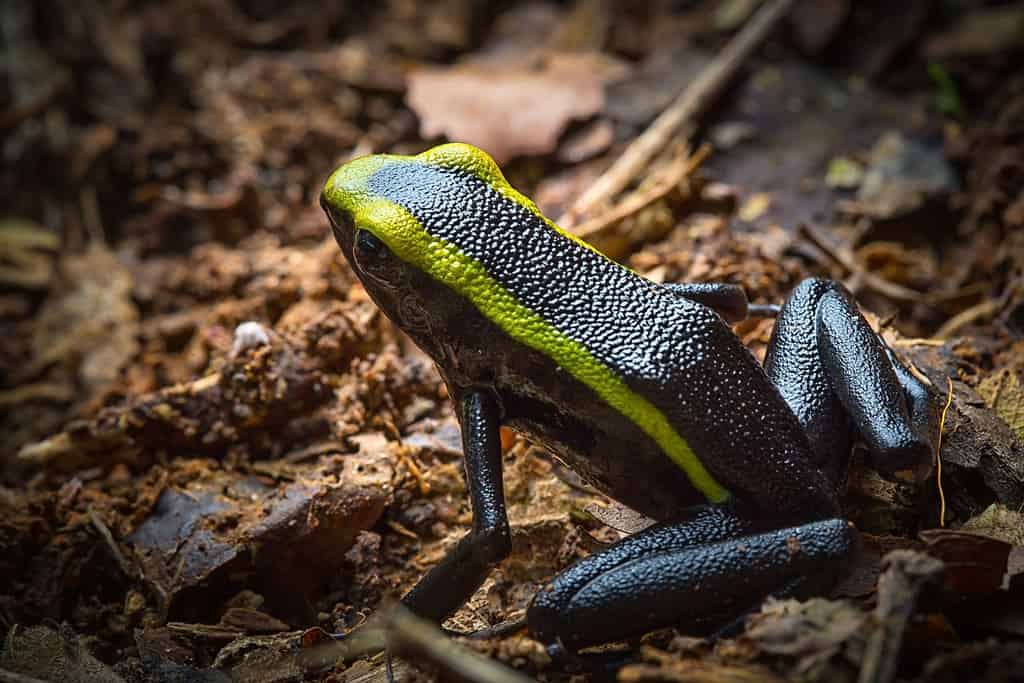
After their little frog eggs have hatched, the male three-striped poison frogs carry their tadpoles to pools of water on their backs.
©iStock.com/kikkerdirk
21. Phantasmal Poison Frog (Epipedobates tricolor)
Found only in Ecuador, the phantasmal poison frog’s colorful patterns are just about as cool as its name. It’s a pretty small frog, measuring less than an inch in length. It has a wide head, short snout, and smooth skin. Phantasmal poison frogs are a red or reddish-brown color, with radiant green or yellow stripes running down their backs. Unfortunately, this species is endangered, meaning that it’s at risk of disappearing forever. There are only a few places where they can be found in the wild, which makes these incredible frogs even more special.
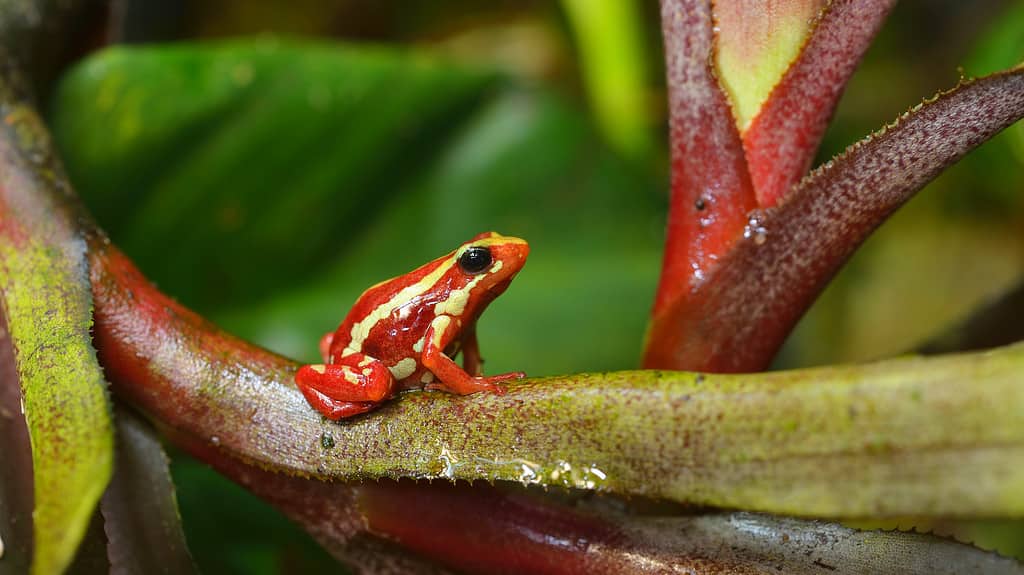
Phantasmal poison frogs live in the Chocoan rainforest.
©iStock.com/alekseystemmer
22. Marañón Poison Frog (Excidobates mysteriosus)
The Marañón poison frog is another incredible yet endangered frog species. It can only be found in the beautiful Cordillera del Condor region, located in the upper Marañón River drainage of the Cajamarca Department in Peru. These frogs love to hang out in primary premontane forests, where they feel right at home.
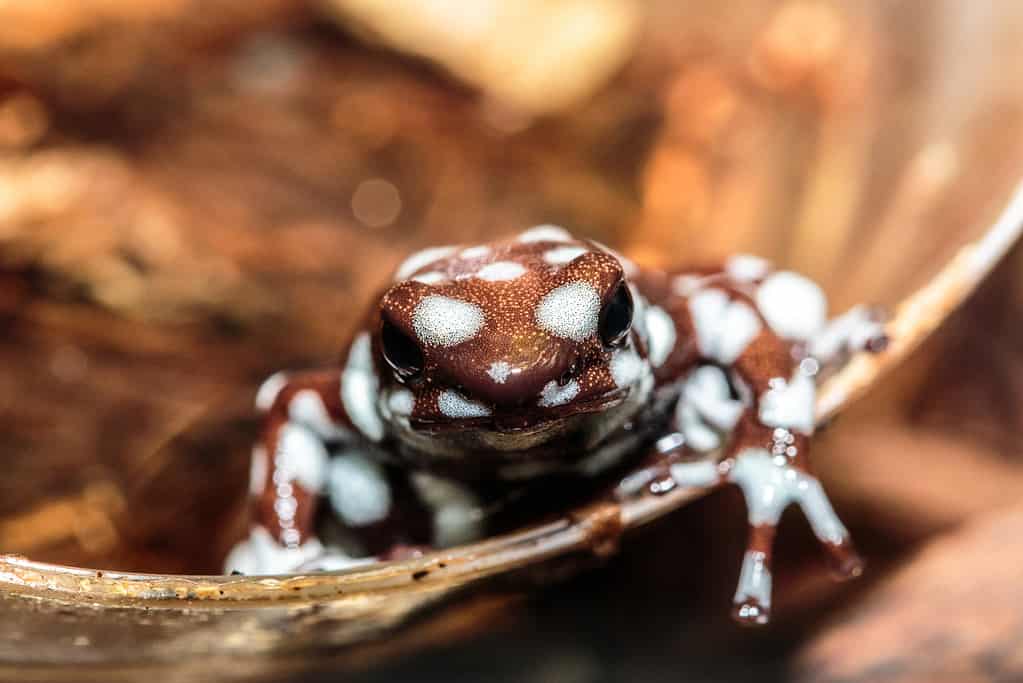
The Marañón poison frog only breeds in bromeliads.
©iStock.com/Rafael Sanchez
The Most Incredible Frogs Throughout the World
| Common Name | Scientific Name |
|---|---|
| Red-Eyed Tree Frog | Agalychnis callidryas |
| Glass Frog | Centrolenidae |
| Amazon Milk Frog | Trachycephalus resinifictrix |
| Giant African Bullfrog | Pyxicephalus adspersus |
| Pobblebonk Frog | Limnodynastes dumerilii |
| Lake Titicaca Water Frog | Telmatobius culeus |
| Harlequin Frog | Atelopus |
| Giant Monkey Frog | Phyllomedusa bicolor |
| Tomato Frog | Dyscophus guineti |
| Riggenbach Reed Frog | Hyperolius riggenbachi |
| Wallace’s Flying Frog | Rhacophorus nigropalmatus |
| Asian Painted Frog | Kaloula pulchra |
| Golden Poison Frog | Phyllobates terribilis |
| Dyeing Poison Dart Frog | Dendrobates tinctorius |
| Strawberry Poison Dart Frog | Oophaga pumilio |
| Red-Backed Poison Dart Frog | Ranitomeya Reticulata |
| Yellow Banded Poison Dart Frog | Dendrobates leucomelas |
| Mimic Poison Frog | Ranitomeya imitator |
| Reticulated Poison frog | Ranitomeya ventrimaculatus |
| Three-Striped Poison Frog | Ameerega trivittata |
| Phantasmal Poison Frog | Epipedobates tricolor |
| Marañón Poison Frog | Excidobates mysteriosus |
The photo featured at the top of this post is © Vaclav Sebek/Shutterstock.com
Thank you for reading! Have some feedback for us? Contact the AZ Animals editorial team.






